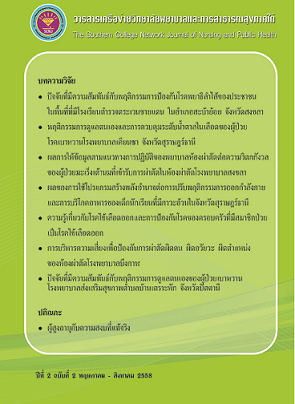การบริหารความเสี่ยงเพื่อป้องกันการผ่าตัดผิดคน ผิดอวัยวะ ผิดตำแหน่ง ของห้องผ่าตัดโรงพยาบาลบึงกาฬ
คำสำคัญ:
การบริหารความเสี่ยง, ความผิดพลาดจากการผ่าตัด, การผ่าตัดผิดคน ผิดอวัยวะ ผิดตำแหน่ง, ห้องผ่าตัด, Risk Management, Wrong-Site Surgery, Operation Roomบทคัดย่อ
การบริหารความเสี่ยงเพื่อป้องกันความผิดพลาดจากการผ่าตัดถือว่าเป็นสิ่งที่สำต่อความปลอดภัยและความไว้วางใจในคุณภาพบริการของผู้รับบริการ การวิจัยเชิงพรรณนา จัดทำขึ้นเพื่อศึกษาการบริหารความเสี่ยงในป้องกันการผ่าตัดผิดคน ผิดอวัยวะ หรือผิดตำแหน่งของห้องผ่าตัด โรงพยาบาลบึงกาฬในแพทย์และพยาบาลวิชาชีพที่ปฏิบัติงานในห้องผ่าตัด จำนวน 30 คน เก็บรวบรวมข้อมูลโดยใช้แบบสอบถามซึ่งประกอบไปด้วยแบบสอบถามข้อมูลทั่วไป แบบประเมินความรู้ในการบริหารความเสี่ยงในป้องกันการผ่าตัดผิดคน ผิดอวัยวะ ผิดตำแหน่งของห้องผ่าตัด แบบสอบถามเกี่ยวกับการปฏิบัติและแบบสอบถามเกี่ยวกับปัญหาและข้อเสนอแนะในการบริหารความเสี่ยงดังกล่าว วิเคราะห์ข้อมูลโดยใช้สถิติเชิงพรรณา และวิเคราะห์เนื้อหา
ผลการวิจัยพบว่ากลุ่มตัวอย่างอายุระหว่าง 23 -57 ปี (M=32.6, SD=10.2) ร้อยละ 32 มีประสบการณ์การทำงานในห้องผ่าตัดน้อยกว่า 1 ปี และร้อยละ 25 ไม่เคยได้รับความรู้หรืออบรมเรื่องการบริหารความเสี่ยงในป้องกันการผ่าตัดผิดคน ผิดอวัยวะ ผิดตำแหน่งของห้องผ่าตัด ค่าเฉลี่ยความรู้อยู่ในระดับสูง(M= 16.43, SD = 2.23) ส่วนค่าเฉลี่ยการปฏิบัติเพื่อป้องกันความผิดพลาดในการผ่าตัดอยู่ในระดับปานกลาง (M= 3.46, SD=1.00) นอกจากนี้ยังพบว่า แนวทางปฏิบัติเกี่ยวกับการทำเครื่องหมายแสดงตำแหน่งที่จะทำผ่าตัดยังไม่ชัดเจน และการปฏิบัติตามแนวปฏิบัติ Time–in, Time-outยังค่อนข้างน้อย ผลการวิจัยในครั้งนี้ชี้ให้เห็นว่าการพัฒนาแนวปฏิบัติที่ดีและการส่งเสริมให้มีการปฏิบัติตามแนวปฏิบัติในการป้องกันหรือลดความเสี่ยงในห้องผ่าตัดเป็นเรื่องที่จำ
Risk Management to Prevent Wrong Person, Wrong Organ, or Wrong Site Operations in the Operating Room at Beung Kan Hospital, Thailand
An effective risk management strategy is essential to prevent surgical procedure errors that affect patient safety and trust in quality of a health care service. Wrong-site surgery includes surgery on the wrong person, the wrong side, the wrong organ or limb, the wrong procedure or the wrong site on the spine. This descriptive research aimed to examine risk management strategy in the prevention of the wrong-site surgery at the BeungKan Provincial hospital in North-eastern Thailand. Participants were 30 surgeons and registered nurses working in the operation room. Research instrument was questionnaire including demographic data, professional knowledge, procedural compliance level, barriers to compliance, and open-ended questions regarding suggestions on universal protocols into prevention of wrong-site operations. Descriptive statistics and content analysis were used to analyze the data.
The study found that the participants’ age range were 23-57 years old (M=32.6, SD=10.2) The percentages of the participants who had worked in the operation room for less than one year, and who had never been trained or educated to risk management for wrong-site surgery prevention, were 32 and 25, respectively. Their average knowledge level was high (M=16.43, SD=2.23), but their universal protocol compliance level was moderate (M= 3.46, SD= 1.00). Moreover, it was found that there were no standard protocols for site-marking. Compliance with guidelines for monitoring Time-in and Time-out was also limited. The findings suggested that practical guidelines to prevent wrong-site surgery need to be developed and that verification procedures need to be strictly used in order to prevent or reduce medical errors related to the wrong-site surgery.
ดาวน์โหลด
เผยแพร่แล้ว
ฉบับ
ประเภทบทความ
สัญญาอนุญาต
1. บทความหรือข้อคิดเห็นใด ๆ ที่ปรากฏในวารสารเครือข่าย วิทยาลัยพยาบาลและการสาธารณสุขภาคใต้ ที่เป็นวรรณกรรมของผู้เขียน บรรณาธิการหรือเครือข่ายวิทยาลัยพยาบาลและวิทยาลัยการสาธารณสุขภาคใต้ ไม่จำเป็นต้องเห็นด้วย
2. บทความที่ได้รับการตีพิมพ์ถือเป็นลิขสิทธิ์ของ วารสารเครือข่ายวิทยาลัยพยาบาลและการสาธารณสุขภาคใต้








